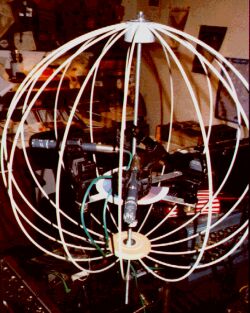PRO:
Privat:
Surroundsoundpage

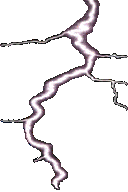


![]()
THE EXPO 2000 PROJECT
The Mission:
Recording atmosphere for an A/V surround projection in 270 degrees.
Choice of Format :
6 channel discrete.
In our view the only format to give the directional information required to give an realistic sound field matching the projection:
5 cardioid mics in angles according to the projection-centers, plus an omni mic for the post-engineer's choice to pan or use for LFE.
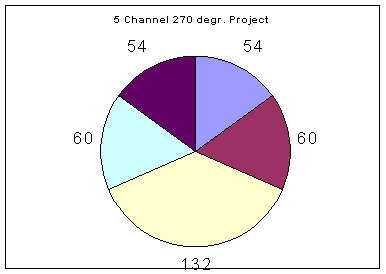 Mic angles
Mic angles
Choice of recording Format:
5 x Neumann KM 84
1 x AKG CK 22
3x Behringer Ultra-Gain pre-amp + Tascam DA 88
The budget had it's limits, and beside that, it fits good in the back of a car, because of it's power consumption (it had to run on a car-battery) and the dimensions and weight (we had to drag it trough the dunes).
Monitoring was achieved by use of a Spirit Notepad to mix the six channels to a pair of stereo headphones.
Microphone angles: = projection angles;
L= -54 degree., C=0 degree., R=+54 degree., Lr= -114 degree, Rr= +114 degree.
Choice of mic placement:
Personal variation on the "Ideal Cardioid Arrangement" as mentioned in the article "Tracking 5.1" AUDIO MEDIA issue 108, nov. 1999.
Mic angles = Projection angles, r=17,5 cm.
Problems:
Windnoise!!!!!!
On our first tryout-day to see everything was working as expected, we encountered two problems.
The first was the a naval battleship testing it's RADAR, coursing a nasty buzz every time the beam passed our position at the waterline, trying to record a real impression of breaking waves at the seashore.
After moving to another location we successfully recorded another take of sea-sound but the problem of wind noise (due to another location) appeared.
The choice of pop-screen with an additional "pussycat" didn't to be sufficient enough to suppress the LF noise of the wind.
Back to the theory and the drawing-board.
Solutions:
The Fluffy Globe.
The Fluffy Globe.
After studying the AES papers "Reduction of wind noise in microphones" by L.R.Burroughs(1961),
I decided to build a custom wind protector for the mic arrangement we decided to use.
R&D of the Fluffy Globe:
Considering the radius of the mic capsule placement (17,5 cm), and the design optimum (maximum surface, still portable), the choice was made to create a globe with a diameter of 50 cm.(19.7")
Designing and Building:
On an M8 thread-rod the following was mounted: (top to bottom):
A topcap to hold 16 fiber bars ,4mm diam.,75 cm long, in a (half) circular manor with an equal radial distance of 22,5 degrees, (see picture).
6 Mic stands with shock absorbent mic-mounts.
Ground plate to fit 16 fiber bars,(4mm diam.,75 cm long, in a circular manor with an equal radial distance of 22,56 degrees).
All this was covered with an fabric of long-hairy, open-woven wool, which was found at the local fabric store.
(For full-size pictures:Surroundsoundpics)
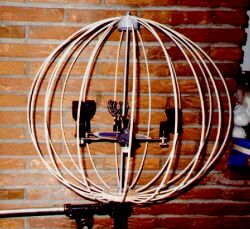 The Cage
The Cage
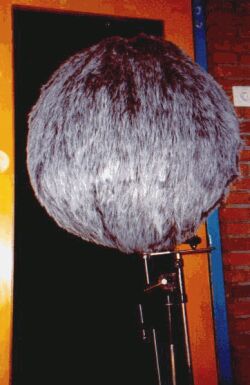 "Fluffy Onion"
"Fluffy Onion"
.
Testing:
Testing was done by installing 2 AKG 390 cardioid mics (in ORTF position) inside the globe and pointing an 80 Watt hairdryer outlet towards it at a distance of 30 and 15 cm from the globe.
Listening sessions and evaluation DAT recordings pointed out that a few more dB's of LF noise suppression could be gained by inserting an extra layer of isolation between the "fluffy coat" and the fiber frame.
A 35 mm thick layer of acoustic fabric ,with a density of 300 gr/sq.mtr. proved to be sufficient.
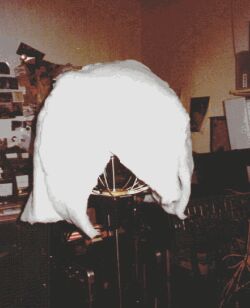 The Blanket
The Blanket
(For full-size pictures:Surroundsoundpics)
In the field:
The first day of real recording included a transfer-hall of a airport and the platform of the same airport.
The transfer-hall gave no problem at all. All air movement due to air-conditioning was excellent suppressed and really convincing surround recordings were made.
After that we went outside to the platform to record general noise of luggage-lorries etc. (including a lucky shot of a jet take-off).
The wind has increased to a 6-7 Beaufort and now we needed to use the HP filters on the pre-amps.
This was the real test for our "Fluffy Onion".
Cutting frequencies @ 40 Hz. proved to be sufficient to get rid of the wind-rumble.
The "Fluffy Onion" worked well!
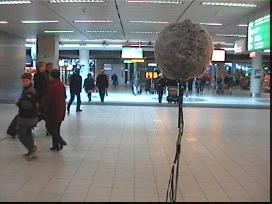
The Transfer-hall.
Following the airport session we had planned to record open landscape sounds in the polder and after a lunch break we tried, but the wind was still increasing and it turned out to be impossible to record anything but the sound of a storm.
After deciding to make the best of the day, we successfully recorded the sound of a wind-turbine because we needed that too in mono as an effect, but we stumbled on it and it made a superb whooossshh,whooossshh!
Our "Fluffy Onion" handled the increasing wind very well.
On our way home we visited a shopping mall to record the general noise of walking, talking people.
Very convincing 10 minutes were recorded before a security woman started to feel important with questions as: "Do you have permission to do this".
Something like: "Do you have a license to hear".
Anybody can walk around with a DV cam and make recordings but when you do it beyond a certain (technical) level ,(Which level? No-one knows!!) you need a permit (and a production-assistant to make the phone-calls and all the other things that drives-up your daily rates); Uniforms do strange things to people.
After cooling-down the situation we called it a day and went home.
Day two:
Our second day of recording was planned (by that before-mentioned production-assistant) to make moving sound fields of the point-of-view of a driver of a Amsterdam Tram (el.streetcar).
Our first option was to place the mics on top of the tram but then (as consequence) we had to wait for 14 hours for the opportunity to remove the mics, due to the transport-schedule.
So we decided to tie our "Fluffy Onion" to the nose of the tram, leading the cables through a window and see what we could capture to tape.
Because we had 2 spare tracks on the DA88, we planted a small A-B pair in the driver's cabin to add reality to the picture.
Two DPA 4060 were attached to the roof of the cabin and gave a fine recording of the sounds of radio-communications and drive-handles moved.
(For full-size pictures:Surroundsoundpics)
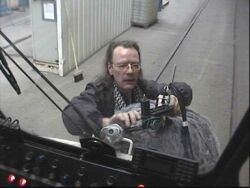 Attaching the "Fluffy
Onion"
Attaching the "Fluffy
Onion"
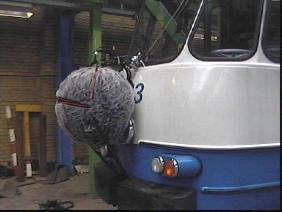 "Airbag"?
"Airbag"?
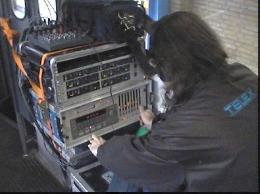 Inside the Tram
Inside the Tram
During the tram ride, successful recordings were made for about 30 minutes, than our battery run out of power due to his age.
At the endpoint we removed the gear in 3 minutes in order not to disturb the transport-schedule.
(Thanks to all the people at Gemeentelijk Vervoers Bedrijf Amsterdam for their cooperation and assistance).
After our tram-ride we moved to the outskirts: the sounds of streaming water and a forest was asked to record. We stopped at the local car-parts dealer to obtain a new battery and drove out.
In the middle of a water-resource in the dunes near Haarlem we captured the various sounds of streaming water and wind moving the trees, accompanied by birdsong.
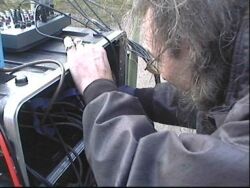
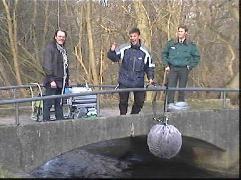
(For full-size pictures:Surroundsoundpics)
The third day:
We were scheduled to record the sounds of a waste-plant to match the picture.
After driving 30 min's, we arrived at the plant and set up the gear very quickly, (By this time we became very familiar with all the connections and patching) and recorded a very realistic sound field of the control-room of the plant, and the sounds of cranes, moving the junk.
After that, we relocated to the unload-platform in order to record the sound of lorries, driving-up and unloading.
(Thanks to all the people at AVI Alkmaar for their help).
In search of sounds of a crowded pub, we were unsuccessful (it was raining "cats and dogs", so there was no crowd), and we decided to go out to record some moving-traffic sounds.
After two try-outs, (failed due to heavy wind and the sound of a road building machine) ,the third was successful; we recorded 6 minutes of superb ambience, located on a highway fly-over.
There is one day to go, so keep coming back for details.
Recent update: Today we visited the audio post-production studio to sort out the different parts and to listen to the results over full-range 5 way monitoring.
Often the realism of the sound-field exceeded our expectations. Specially the recordings of the streetcar and the sounds of the waste-plant were very impressive! Also the streaming-water-sound makes you want to go to the bathroom.
The directional information in the airport-hall was very good; when a coin was dropped behind us, everybody was turning around to pick it up. Also people walking by were very good to "follow", audio-wise, without "holes" between mics/speakers.
Because the mics were relatively close together during recording we were happily surprised by the phenomenon of (vertical in-phase) LF coupling. The unloading of the lorries at the waste-plant made de floor shake without any use of a subwoofer, we feeded 5 channels from the DA88 straight in the monitors.
After all a encouraging listening-experience.
We also like to thank the people at Bob Kommer Sound Studios bv for their hospitality and encouragement and we look forward to the mix-down, which must be done in the pavilion in Hanover, because for placing the effects etc., the (computer-generated) projection in 270 degrees is needed.
Update: 11 April 2000:
Today, first we visited Euro Container Terminal at Rotterdam Seaport in order to record surround sound fields of containers being unloaded from ships and moved to lorries. The whether was nice, so everything went smooth. Also on the technical side everything worked as expected. Doing it for the fourth day gave a feeling of routine.
After driving to Amsterdam, we recorded the atmosphere of the Leidseplein. We were lucky to get a spot to park our car nearby, (after violating several traffic rules, but that seems to be the only way to get somewhere in Amsterdam), and we had 80 mtr.(260 ft), 12 ch.multicore available for these situations.
The next thing to capture (sound wise), was a train So we went to the outskirts.
Near Abcoude we discovered a quiet spot in the landscape which turned out to be a superb site to record several passing trains; just as close as you want to get and no disturbing sounds (except for some air traffic), but what background noise do you hear when a train passes at a distance of 2m (6 ft)?
The last thing to do was to record the atmosphere of a so called "Grand Cafe", so we went back to the center of Amsterdam. Production people made arrangements with "De Balie" (Thanks for their hospitality), but parking near the spot is a roulette with the police. We took the chance of a ticket and parked in front of the building and moved the gear in and out within 18 minutes and recorded successfully 10 minutes of "Grand Cafe Atmosphere". (And got out with "burning rubber", 2 fast 4 the parking-police).
After that, we called it a (successful) day and went home.
The next day, the multitrack tapes were delivered to the studio and so far our mission is completed. If possible, we go to Hanover to visit the mixdownsession.
Update: 04 June 2000:
The show is running and the critics are very positive. People reported the sound as very realistic and larger than life. I myself couldn't find the time to go there, due to a very busy agenda (we have some sort of ballgame Championship over here and TV facilities are making overtime). If we have some more detailed information we let you know.
Update:
25 July 2000:By now, the Expo 2000 turned out not to be the success the organization expected it to be. The figure of visitors remained low and it is surprising that there is a queue-line for the entrance of the Dutch pavilion. I hope it is because of the (detailed) quality of the sound, but my sense of reality tells me that the snacks must be cheaper over there.
Update: 5
November 2000:The Expo 2000 has ended by now, and the Dutch pavilion turned out to be one of the most successful.
There are plans to save the building for the future, sponsored by Dutch and German electricity companies. I don't know what will happen to the 270 degrees projection and the soundtracks. Anyway, the job was interesting to do and we will be happy to do such experimental work again .
Update: 30 July 2002:
No more news so far from the surround side of business, exept that I mix as much as I can in surround for my regular TV programs. I think it gives the at home watching audience a feeling of involvement. If it's done right you give them the feeling they were "live" present, like the stiudio guests, watching the show.
Some Technical Tips:
Align your equipment and levels as careful as possible, avoiding mismatches between channels!
Come on boys, (Video Editors included!) keep the level mismatch between Lt and Rt < 0,5 dB. Use a good stereo fader instead of two mono channels. Dolby ProLogic is the "Real World Maximum" in my working environment at this moment, and this Lt+Rt signal must be considered as one signal, consisting of two components ( Lt+Rt ), like the RGB are three for component television.
Lt is LEFT and Rt is RIGHT!!! DON'T REVERSE !!!!! The decoded signal gives directional ambience information and it is very "Illusion Disturbing" seeing someone walking in from the left side of the picture while your ears predicted she/he should be coming from the right.
Dick Korporaal & Arnoud van Laer
We hope to keep you informed about this and other (future) projects, so check regularly.
Also for questions and comments: dick@n-s-e.com
dick@n-s-e.com
If it is urgent:

phone: (Arnoud) ++31(0)653857575 or (Dick) ++31(0)653486977
![]()
The DA 88: http://www.aem.nl
The studio: http://www.bkssound.com
For more on this subject:

http://www.harman.com/wp/pdf/HowManyChannels.pdf
http://www.jblpro.com/pub/technote/tn_v3n03.pdf
Books:
5.1 Surround Sound by Tomlinson Holman
![]()
